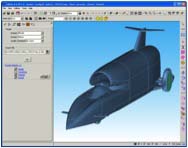Latest News
July 29, 2010
By DE Editors
 |
ITI TranscenData will be using its presence at two industry events later this year to showcase the role CADfix, its CAD translation and repair software, has played in the development of the BLOODHOUND Supersonic Car (SSC), a car that has been designed to beat the land-speed record by clocking more than 1,000 miles per hour. ITI TranscenData will be explaining the role of CADfix in the design and analysis phase of the project on its stand at the Siemens PLM Europe conference in Linz, Austria from Oct. 18 - 20, where the BLOODHOUND team will also be giving a keynote presentation, and at Aero Engineering 2010 in Birmingham, UK from Sept. 29 - 30.
The BLOODHOUND project is the brainchild of Richard Noble OBE, who has set out to build a car capable of achieving 1,000mph. If BLOODHOUND SSC achieves its target, it will mark the greatest incremental increase in the history of the world land speed record — currently standing at just over 763mph — and will also see a car exceeding the low-altitude speed record for aircraft.
CADfix removes the barriers that prevent the effective reuse of CAD geometry in downstream applications by providing an extensive set of geometry manipulation tools for importing and repairing CAD data, and then conditioning and exporting it in the most suitable form for reuse in the receiving software package. It also features a number of specific tools designed to refine 3D geometry for use in mesh-based analysis tools, where, for instance, small “sliver” surfaces can cause unnecessary mathematical complications.
CADfix acting as a link between the Bristol-based design team and the aerodynamics team, based at Swansea University. The master design was created in NX, from Siemens PLM, while simulation of the car was undertaken in FLITE, a specialist computational fluid dynamics (CFD) tool developed at the university, versions of which are in use at leading European aerospace manufacturers.
“FLITE is a dedicated meshing and CFD solving application, and it’s very good at what it does,” explains Professor Oubay Hassan, who was awarded an MBE for his work on Noble’s first supersonic car, Thrust SSC. “But while we’re experts on engineering software, we haven’t evolved a CAD interface. In order to work with the geometry coming out of the design team we’d have had to write a new converter or input it all by hand. And given the tight development schedule this would have been too much of a challenge.”
CADfix provided the link. Without it, professor Hassan estimates the analysis would have taken an extra 12 months and the project would have had no chance of meeting its tight design window.
For more information, visit TranscenData.
Sources: Press materials received from the company and additional information gleaned from the company’s website.
Subscribe to our FREE magazine, FREE email newsletters or both!
Latest News
About the Author
DE’s editors contribute news and new product announcements to Digital Engineering.
Press releases may be sent to them via [email protected].






